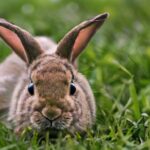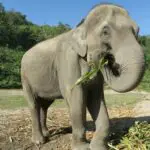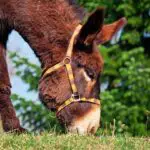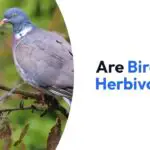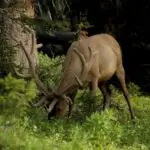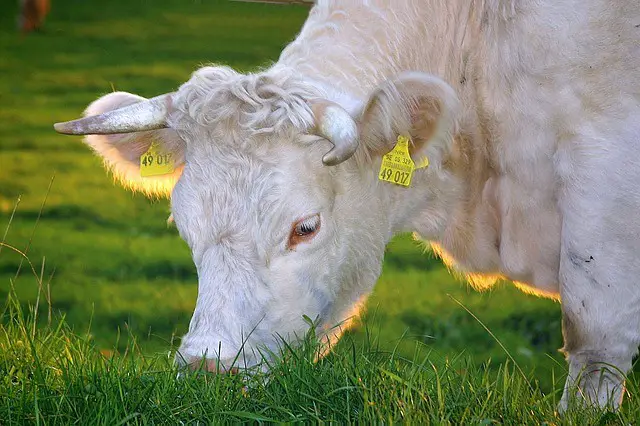
Farm animals that eat grass are a vital part of many agricultural systems around the world. These animals are known as grazing animals and include species such as cows, sheep, goats, horses, and bison, among others.
In this post, we will explore which animals eat grass on a farm, what the benefits and drawbacks of these animals are, as well as their unique digestive system.

Contents
- Animals that Eat Grass
- Benefits & Drawbacks of Farm Animals that Eat Grass
- Examples of Farm Animals that Eat Grass
- Digestive System of Grass Eaters
- Are Donkeys Good for Keeping Grass Down?
- Final Thoughts
Animals that Eat Grass
Animals that eat plants only are known as herbivores. In this group of herbivores, there are some animals that eat primarily grass as their source of plant-based food.
These animals that eat grass are called graminivores or grazers. You can also find more examples of these animals at:
Benefits & Drawbacks of Farm Animals that Eat Grass
One of the main benefits of farm animals that eat grass is that they are able to convert inedible plant material into food for humans. Grass is a type of plant that is abundant and easy to grow, making it a cost-effective and sustainable food source for these animals. Additionally, grazing animals are able to use land that is not suitable for other forms of agriculture, such as land that is too steep or too dry for crops.
Another benefit of farm animals that eat grass is that they play a vital role in maintaining the health of grasslands and other natural ecosystems. By grazing on grass, these animals help to control the growth of invasive plants, promote the growth of native plants, and maintain the diversity of plant and animal life in these ecosystems. This is known as holistic grazing management.
Grazing animals also help to improve soil health by trampling and fertilizing the soil with their manure. This can help to improve soil structure, increase water retention, and promote the growth of beneficial microorganisms in the soil.
Despite the benefits, grazing animals can also have negative impacts on the environment if not managed properly. Overgrazing can lead to soil erosion, loss of biodiversity, and other environmental problems. Additionally, grazing animals can also compete with native wildlife for food and habitat, and can introduce invasive plants and diseases into natural ecosystems.
To mitigate these negative impacts, it is important to use sustainable grazing practices. This includes using rotational grazing methods that move animals from one pasture to another, allowing the land time to recover, using fencing to protect sensitive areas, and monitoring the health of the land to ensure that it is not being overgrazed.
Another important aspect of sustainable grazing is to ensure that the animals are treated humanely and with care. This includes providing them with adequate food, water, and shelter, and avoiding overcrowding or other forms of stress.
In summary, farm animals that eat grass are an important part of many agricultural systems around the world. They are able to convert grass into food for humans, maintain the health of grasslands and other natural ecosystems, and improve soil health. However, to ensure that the environmental and animal welfare impacts are minimized, it is important to use sustainable grazing practices such as rotational grazing, protecting sensitive areas, and monitoring the health of the land and the animals.
Examples of Farm Animals that Eat Grass
Here are some animals that eat grass on farms. (For a full list of animals that are not only farm animals, see Over 25 Animals that Eat Grass)
Cows
Cows are one of the most well-known grazing animals. They are able to eat a wide variety of grasses, including both cool-season and warm-season varieties. They are also able to eat legumes, such as clover and alfalfa, as well as forbs, which are herbaceous plants that are not grasses.
Sheep
Sheep are another type of grazing animal. They are also able to eat a wide variety of grasses, legumes and forbs, as well as other types of vegetation such as shrubs and trees. Sheep are known for their ability to graze on land that is too steep or rocky for other types of livestock.
Goats
Goats are known for their ability to eat a wide variety of vegetation, including grasses, legumes, forbs, shrubs, and trees.
Goats are also known for their ability to control the growth of invasive plants and maintain the health of natural ecosystems.
Horses
Horses are another type of grazing animal that eats a lot of grass. They are able to eat a wide variety of grasses as well as other types of vegetation such as shrubs and trees.
Bison
Bison, like cows, also eat lots of grass. They also eat weeds and leafy green plants.
Other Animals
In addition to these grazing animals, there are also other less common farm animals that are grass eating animals such as camels, llamas, alpacas, and yaks, they also have a specialized stomach and are able to convert grass into food.
Digestive System of Grass Eaters
All these animals are ruminants, which means they have a specialized stomach that allows them to digest tough plant material like grass, hay, and silage. They are able to extract the nutrients from these plants by regurgitating and re-chewing their food, a process known as rumination.
Are Donkeys Good for Keeping Grass Down?
Donkeys can be good for keeping grass down on a farm. They are known for their ability to graze on a wide variety of vegetation and can navigate uneven terrain. They also have a natural tendency to graze on invasive plants, which can help to control the growth of these plants.
Final Thoughts
In conclusion, farm animals that eat grass are a vital part of many agricultural systems around the world. They are able to use grass for food, maintain the health of grasslands and other natural ecosystems, and improve soil health.
Cows, sheep, goats, horses, and bison are some of the most well-known grazing animals, but there are also other farm animals such as camels, llamas, alpacas and yaks that consume grass. These animals are able to extract the nutrients from grass through the process of rumination, which allows them to convert tough plant material into food for humans. Grazing animals also play an important role in land management, helping to maintain the health of grasslands and other natural ecosystems.
It’s important to note that the diet of these grazing animals can vary depending on the location and the species. Some animals can be fed with supplements such as grains and concentrates to provide them with a balanced diet and to improve their growth and health.
Also, the way the animals are managed can affect their diet, for example, animals that are raised in feedlots are typically fed a diet that is primarily composed of grains and concentrates, while animals that are raised on pasture are able to graze on grasses and other vegetation.
Lance has been passionate about the plant-based diet and we have been following a whole food plant-based diet for over 5 years. We focus on health, natural healing, weight management, animal rights, and the health of the planet and environment by focusing on whole plant-based foods and sustainable practices.
Learn more at the About Me page and follow on social media at the links below.

